Restored by The Film Foundation’s World Cinema Project and Fundación Televisa at L’Immagine Ritrovata in collaboration with Filmoteca UNAM and in association with Televisa S. de R.L. de C.V. Funding provided by the Golden Globe Foundation. Special thanks to Guillermo del Toro.

The World Cinema Project (WCP) preserves and restores neglected films from around the world. To date, 67 films from Africa, Asia, Eastern Europe, Central America, South America, and the Middle East have been restored, preserved and exhibited for a global audience. The WCP also supports educational programs, including Restoration Film Schools; intensive, results-oriented workshops allowing students and professionals worldwide to learn the art and science of film restoration and preservation. All WCP titles are available for exhibition rental by clicking "Book This Film."
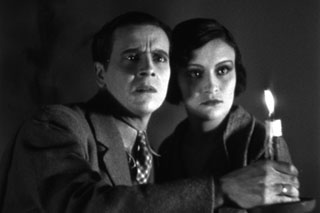
FANTASMA DEL CONVENTO, EL
Director: Fernando de Fuentes
WRITTEN BY: Jorge Bezet, Fernando de Fuentes, Juan Bustillo Oro
DIRECTOR OF PHOTOGRAPHY: Ross Fisher
PRODUCER: Jorge Bezet
STARRING: Enrique del Campo, Marte Roel, Carlos Villatoro, Paco Martínez, Victorio Blanco
COUNTRY OF PRODUCTION: Mexico
LANGUAGE: Spanish with English subtitles
COLOR INFO: Black and White
RUNNING TIME: 85 minutes
PRODUCER: Jorge Bezet
Restored by UCLA Film & Television Archive and The Film Foundation’s World Cinema Project, with funding provided by the George Lucas Family Foundation.
NOTES ON THE RESTORATION:
Preserved from the 35mm nitrate picture and track negatives and a 16mm acetate composite dupe negative. Laboratory services by Fotokem, Roundabout Entertainment, Inc., Audio Mechanics, DJ Audio, Inc., Titrafilm Paris. Special thanks to Viviana Garcia Besne, Permanencia Voluntaria; Albino Álvarez Gómez, Filmoteca de la UNAM.
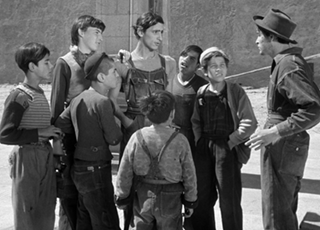
LOS OLVIDADOS
Director: Luis Buñuel
WRITTEN BY: Luis Buñuel, Luis Alcorira
EDITING: Carlos Savage
DIRECTOR OF PHOTOGRAPHY: Gabriel Figueroa
PRODUCER: Óscar Dancigers, Sergio Kogan, Jaime A. Menasce
MUSICAL DIRECTOR: Rodolfo Halffter
STARRING: Estela Inda, Miguel Inclán, Alfonso Mejía, Roberto Cobo, Alma Delia Fuentes
COUNTRY OF PRODUCTION: Mexico
LANGUAGE: Spanish with English subtitles
COLOR INFO: B&W
RUNNING TIME: 80 minutes
PRODUCER: Óscar Dancigers, Sergio Kogan, Jaime A. Menasce
Restored by The Film Foundation's World Cinema Project in collaboration with Fundacion Televisa, Televisa, Cineteca Nacional Mexico, and Filmoteca de la UNAM.
Restoration funding provided by The Material World Foundation.
NOTES ON THE RESTORATION:
LOS OLVIDADOS was restored in 4K from the camera and soundtrack nitrate negatives preserved at Filmoteca de la UNAM. The film reels were scanned at UNAM laboratory and the soundtrack was digitized by Cineteca Nacional de México.
Special thanks to Gabriel Figueroa Flores for his supervision of the grading process.
The restoration work was carried out by L'Immagine Ritrovata in 2019.
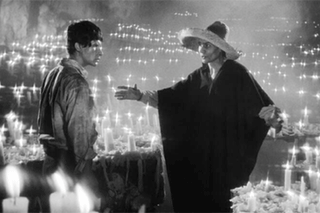
MACARIO
Director: Roberto Gavaldón
EDITING: Gloria Schoemann
DIRECTOR OF PHOTOGRAPHY: Gabriel Figueroa
ADAPTED BY: Emilio Carballido, Roberto Gavaldón
MUSICAL DIRECTOR: Raúl Lavista
STARRING: Ignacio López Tarso, Pina Pellicer, Enrique Lucero, José Gálvez, José Luis Jiménez, Mario Alberto Rodríguez, Consuelo Frank
COUNTRY OF PRODUCTION: Mexico
LANGUAGE: Spanish with English subtitles
COLOR INFO: B&W
RUNNING TIME: 91 minutes
NOTES ON THE RESTORATION:
MACARIO was restored from the original camera and sound negatives preserved at Televisa. Image scanning at 4K resolution and audio digitization work was completed by Filmoteca UNAM. Restoration of the picture and sound was carried out at L'Immagine Ritrovata in 2023.
Special thanks to Gabriel Figueroa Flores for supervising the color grading.
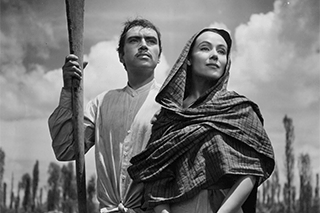
MARÍA CANDELARIA
Director: Emilio Fernández
WRITTEN BY: Emilio Fernández, Mauricio Magdaleno
EDITING: Jorge Bustos, Gloria Schoemann
DIRECTOR OF PHOTOGRAPHY: Gabriel Figueroa
PRODUCER: Agustín J. Fink
STARRING: Dolores Del Río, Pedro Armendáriz, Alberto Galán, Margarita Cortés, Miguel Inclán
COUNTRY OF PRODUCTION: Mexico
LANGUAGE: Spanish with English subtitles
COLOR INFO: Black and White
RUNNING TIME: 102 minutes
PRODUCER: Agustín J. Fink
Restored in 2024 by the Academy Film Archive, TelevisaUnivision, Filmoteca UNAM, and The Film Foundation's World Cinema Project. Restoration funding provided by the Material World Foundation.
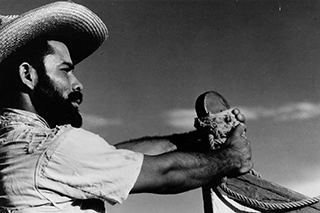
REDES
Director: Fred Zinnemann, Emilio Gómez Muriel
WRITTEN BY: Agustín Velázquez Chávez, Paul Strand
EDITING: Emilio Gómez Muriel, Gunther von Fritsch
DIRECTOR OF PHOTOGRAPHY: Paul Strand
ADAPTED BY: Emilio Gómez Muriel, Fred Zinnemann and Henwar Rodakiewicz
MUSICAL DIRECTOR: Silvestre Revueltas
SOUND: Roberto, Joselito Rodriguez
FROM: Cinemateca de la UNAM, Mexico
STARRING: Silvio Hernández (Miro), David Valle González (Monopolist), Rafael Hinojosa (Politician), Antonio Lara (El Zurdo), Miguel Figueroa and native fishermen
COUNTRY OF PRODUCTION: Mexico
LANGUAGE: Spanish with French and English subtitles
COLOR INFO: Black and White
RUNNING TIME: 61 minutes
PRODUCTION COMPANY: Secretaría de Educación Pública
Restored in 2009 by Cineteca di Bologna/L'Immagine Ritrovata laboratory, in association with The Film Foundation’s World Cinema Project and Filmoteca de la UNAM. Restoration funded by Armani, Cartier, Qatar Airways and Qatar Museum Authority.
The film – the first (and last) of its kind – was expected to play a small part in the Government’s plan to educate millions of illiterate citizens throughout the enormous country and bring them out of their isolation. […] The picture was to be made for the Federal Department of Fine Arts, headed by composer Carlos Chávez. The producer would be Paul Strand. […] We had recruited practically all ‘actors’ from among the local fishermen, who needed to do no more than be themselves. They were splendid and loyal friends, and working with them was a joy. In addition to acting, they carried all the equipment, rowed the boats and did a multitude of other jobs, earning more money than ever before – forty-five cents per day, per man – and enjoying themselves hugely. […] I’m told that some years later the Nazis found the negative in Paris and burned it. A few prints still exist. –Fred Zinnemann
NOTES ON THE RESTORATION:
The restoration of Redes used the best surviving materials, namely a 35mm safety duplicate negative and a positive print preserved at the Filmoteca de la UNAM in Mexico. The digital restoration produced a new 35mm internegative.
Image: © Courtesy of Filmoteca de la UNAM
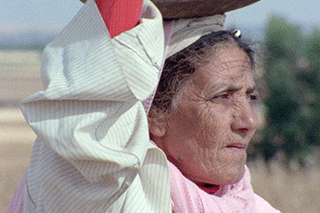
ALYAM, ALYAM
Director: Ahmed El Maanouni
WRITTEN BY: Ahmed El Maanouni
EDITING: Martine Chicot
DIRECTOR OF PHOTOGRAPHY: Ahmed El Maanouni
MUSICAL DIRECTOR: Nass el Ghiwane
SOUND: Ricardo Castro
PRODUCTION DESIGN: Rabii Films
STARRING: Toualàa villagers (Oulad Ziane) in the Casablanca region, and in particular: Abdelwahad and his family, Tobi, Afandi Redouane and Ben Brahim
COUNTRY OF PRODUCTION: Morocco
LANGUAGE: Arabic, French with English subtitles
COLOR INFO: B&W
RUNNING TIME: 90 minutes
Restored by Cineteca di Bologna/L’Immagine Ritrovata laboratory, in association with Ahmed El Maanouni. Restoration funded by The Film Foundation’s World Cinema Project.
Alyam, Alyam is a film about shattered dreams and the circumstances leading up to that point; about the shaking of the traditional social structure; about the strength born of desperation and the unrelenting dissipation of lost generations. This is stressed from the first notes of the opening music, by the strangely empty building frame that is slowly filled with people, by the village space, by the silence of the wandering woman who smokes, until the last shot of the film, when a crowd appears from behind a deserted hill. The dreams of a society growing smaller, unable to hold on to the resources that could help it survive, are mirrored by the mother’s helpless prayer, “I need your shadow, I need your light, I need your face.”
I simply wanted to show the farmers’ faces, to honor their sounds and their images, their silences and their words, and that’s why I chose not to interfere and to opt for deliberately restrained composition, movement and mise-enscène. I tried to minimize the camera’s ability to distort, make a point, or discriminate. I wanted each aspect to be presented equally. I did not look for spectacular beauty, but made an effort to let the imagery of the rural world speak through abstraction and silence.
Almost 40 years later, when I watch Alyam, Alyam again, I am still comfortable with my aesthetic choices and my intuitions, but I cannot avoid noticing how, from beginning to end – from the opening shots with the blood shed by the camels, to the crowd of peasants appearing from behind the hills – it all seemed to presage the current tragedy experienced by the thousands whose broken dreams lie at the bottom of the Mediterranean, on which the voice of Nass El Ghiwane’s Larbi Batma seems to strangely resonate: “Alyam, Alyam, oh, those were the days! Why are you crossed? Who changed your course? You were once sweet like milk, now you’re bitter. I love all men as if they were my brothers. My brothers have crushed me. I will silence my pain and let my love be loud.”- Ahmed El Maanouni
NOTES ON THE RESTORATION:
The restoration of Alyam, Alyam used the 16mm A/B rolls original camera and sound negatives preserved at Eclair Laboratories, where the 4K scan was performed. Restoration - carried out at Cineteca di Bologna/L’Immagine Ritrovata - succeeded in stabilizing the image and bringing the original chromatic qualities to light. Director Ahmed El Maanouni supervised the color grading process and approved the final restoration.
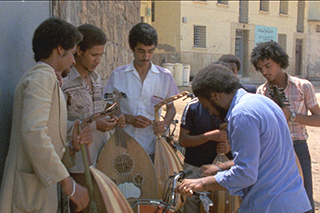
TRANCES
EL HAL
Director: Ahmed El Maanouni
WRITTEN BY: Ahmed El Maanouni
EDITING: Jean-Claude Bonfanti
DIRECTOR OF PHOTOGRAPHY: Ahmed El Maanouni
PRODUCER: Izza Génini
MUSICAL DIRECTOR: Nass El Ghiwane
STARRING: Nass El Ghiwane
COUNTRY OF PRODUCTION: Morocco
LANGUAGE: Arabic
COLOR INFO: Color
RUNNING TIME: 87 minutes
PRODUCTION COMPANY: OHRA/SOGEAV
PRODUCER: Izza Génini
Restored in 2007 by Cineteca di Bologna/L’Immagine Ritrovata laboratory, in association with The Film Foundation’s World Cinema Project, Ahmed El-Maanouni, and Izza Genini. Restoration funded by Armani, Cartier, Qatar Airways and Qatar Museum Authority.
“It was in 1981 while I was editing a film, The King of Comedy. We worked at night so no one would call us on the telephone and I would have television on, and one channel in New York at the time, around 2 or 3 in the morning, was showing a film called Transes. It repeated all night and it repeated many nights. And it had commercials in it, but it didn’t matter. So I became passionate about this music that I heard and I saw also the way the film was made, the concert that was photographed and the effect of the music on the audience at the concert. I tracked down the music and eventually it became my inspiration for many of the designs and construction of my film The Last Temptation of Christ. […] And I think the group was singing damnation: their people, their beliefs, their sufferings and their prayers all came through their singing. And I think the film is beautifully made by Ahmed El Maanouni; it’s been an obsession of mine since 1981 and that is why we are inaugurating the Foundation with Trances.” –Martin Scorsese, May 2007
NOTES ON THE RESTORATION:
Notes on the restoration
The restoration of Trances used the original 16mm camera and sound negative provided by producer Izza Génini. The camera negative was restored both photochemically and digitally and blown-up to 35mm format. The sound negative was restored to Dolby SR and digital.
Image: © Courtesy of OHRA-Izza Génini
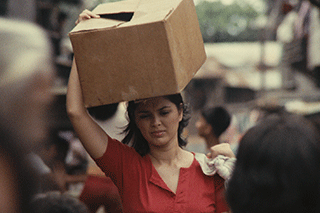
INSIANG
Director: Lino Brocka
WRITTEN BY: Mario O’Hara and Lamberto Antonio
EDITING: Augusto Salvado
DIRECTOR OF PHOTOGRAPHY: Conrado Baltazar
PRODUCER: Miguel De Leon Severino
MUSICAL DIRECTOR: Max Jocson
SOUND: Luis Reyes, Ramon Reyes
STARRING: Hilda Koronel, Mona Lisa, Ruel Vernal, Rez Cortez, Marlon Ramirez
COUNTRY OF PRODUCTION: Philippines
LANGUAGE: Tagalog with French and English subtitles
COLOR INFO: Color
RUNNING TIME: 124 minutes
PRODUCER: Miguel De Leon Severino
Restored by Cineteca di Bologna/ L’Immagine Ritrovata. Restoration funded by The Film Foundation’s World Cinema Project and the Film Development Council of the Philippines.
I’m so pleased that Insiang, the second of the great Lino Brocka’s films that we’ve managed to restore, has been selected for this year’s Cannes Classics: back in 1976, this extraordinary family melodrama was the first picture from the Philippines ever selected for Cannes. Brocka was like a force of nature in world cinema, and Insiang was among his greatest achievements. - Martin Scorsese, May 2015
Insiang is, first and foremost a character analysis: a young woman raised in a miserable neighborhood. I need this character to recreate the ‘violence’ stemming from urban overpopulation, to show the annihilation of a human being, the loss of human dignity caused by the physical and social environment and to stress the need for changes to these life conditions […] My characters always react through fighting. I have conceived Insiang like an immoral story: two women share the same man, the daughter avenges herself and, in the end, she reveals herself: she had conspired to kill her mother’s lover without having ever loved him, so that the murder was, in fact, unnecessary. Censorship refused this ending.” - Lino Brocka
In 1977 I was in Sydney for the film festival. Before going home, I zigzagged my way back through Jakarta, Singapore, Kuala Lumpur, Hong-Kong, Manila and Seoul, to discover a new filmmaker and an unknown film: Insiang by Lino Brocka. When Insiang was released on December 17, 1976, it did not do well, and led to the collapse of CineManila, the company founded by Brocka in 1974 after the extraordinary success of Tinimbang Ka Ngunit Kulang. The shooting of Insiang began on December 1 and lasted 11 days. Knowing these dates is important as they reveal the extreme urgency he felt, and his unique, authentic desire to make this film. Insiang also presents an unusual, brilliant mise-en-scène which shows the characters being torn apart by passion, by a sort of ardent energy. I am very pleased that, two years after Manila in the Claws of Light, Cannes Classics is showcasing another restoration of a Brocka film. I still remember the excitement, along rue Antibes, surrounding the screening of Insiang at the Quinzaine de Réalisateurs, in 1978. That was a very fulfilling and emotional experience, and I’m sure the same will be true today. - Pierre Rissient
NOTES ON THE RESTORATION:
The restoration of Insiang was made possible through the use of the original camera and sound negatives deposited at LTC laboratories by producer Ruby Tiong Tan.
The negative was wet-scanned at 4K resolution and digital restoration was very time-consuming. Some portions of the film, where the negative was intercut to the internegative were extremely damaged and two shots were replaced by use of a 35mm positive print preserved at the BFI National Archive.
Despite an overall acceptable state of preservation, the original optical sound negative presented critical recording issues. The sound restoration required considerable effort to try and solve or minimize the severe metallic hiss and distortions. Several acquisition methods were tested, leaving, however, very little room for improvement.
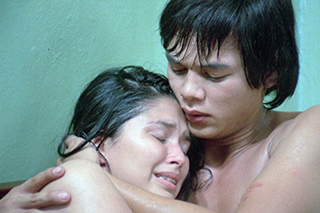
Manila in the Claws of Light
MAYNILA SA MGA KUKO NG LIWANAG
Director: Lino Brocka
EDITING: Edgardo Jarlego, Ike Jarlego
DIRECTOR OF PHOTOGRAPHY: Miguel De Leon
ADAPTED BY: Edgardo Reyes
PRODUCER: Miguel De Leon, Severino Manotok
MUSICAL DIRECTOR: Max Jocson
SOUND: Luis Reyes, Ramon Reyes
ART DIRECTOR: Miguel De Leon
STARRING: Bembel Roco, Hilda Koronel, Rafael Roco Jr., Lou Salbador Jr., Tommy Abuel, Jojo Abella, Juling Badabaldo
COUNTRY OF PRODUCTION: Philippines
LANGUAGE: Tagalog with French and English subtitles
COLOR INFO: Color
RUNNING TIME: 124’
PRODUCER: Miguel De Leon, Severino Manotok
Restored in 2013 by the Film Development Council of the Philippines and Cineteca di Bologna/L’Immagine Ritrovata laboratory, in association with The Film Foundation’s World Cinema Project , LVN, Cinema Artists Philippines and Mike De Leon. Restoration funded by Doha Film Institute.
There are undoubtedly a few people left who still remember that day in Cannes 1978 when rumors started circulating about a small, low budget film from the Philippines. A ‘dirty’ film, as some claimed, once more proving Lu Xun correct when he observed that while some art might originate in the sewer, it can be so full of passion that it goes as deep as tragedy.
And perhaps even further, because Lino was one of the most physical filmmakers that cinema has ever had. A true fireball, he moved insatiably from one set to rehearsals of Larawan in Fort Santiago where he directed a very dedicated group of actors, then on to a TV set where he would shoot a TV show in addition to a film as good as A Streetcar Named Desire.
He possessed a remarkable vitality that was expressed fully in the large demonstrations he organized against Marcos’ regime. With the money he made with his commercial films he bought some sophisticated sound equipment that allowed him to cover the entire Epifanio de los Santos Avenue, Manila’s massive north to south transportation corridor. Lino knew all the arteries of this swarming city, and he penetrated them just as he penetrated the veins of the outcasts in his films. Sometimes a vein would crack open and bleed. And that blood oozed on the screen with Insiang, Jaguar, Bona, Bayanko, all of which were shown in Cannes. And then, just like that, he died, in a stupid, easily avoidable car accident.
I remember a dinner, five weeks after Marcos’ fall, when Lino had realized that the Aquino regime would lead nowhere. He was no longer the same, nor were his films. He even lost his ability to joyfully seize the moment, which he was able to spread around among his friends.
Still, when you watch Manila, you’ll be burned by a flame that never goes out.
-Pierre Rissient, May 2013
A film director can survive in a museum, on a field or in the jungle – first, second or third world. In the third-world jungle he will be judged by his ability to survive, by the way he insists on making committed films and on believing in the power of cinema, even if no one ever asked him to do so. The rest stands on its own two feet. The aesthetics is a consequence.
A third-world filmmaker necessarily has to reinvent his own brand new cinema, squeezed by the rule of immediate profit (tougher in cinema than anywhere else), and the risk of a brutal clash with power. These are the directors who affect us deeply. Satyajit Ray in the 50’s, Ousmane Sembène in the 60’s, Lino Brocka at the end of the 60’s, and again Lino Brocka at the end of the ‘70s and today. [...]
Ultra-fast, fiercely vital, unclassifiable, this little man exists right in the heart of his country. He knows and experiences all the contradictions of Filipino culture and cinema. Brocka is not a solitary hero, he is a public figure; though marginal, exposed, and slandered, he is protected by his fame abroad. He has some key traits in common with Pasolini: a respect for “lower” culture, a feeling for the beauty of the body, a willingness to dissect the social links that the bodies represent.
Brocka loves flinging his characters into the traps of mise en scène, he never turns away when they are overwhelmed by emotion, and once they are cornered, neither can we.
-Serge Daney, 1981
NOTES ON THE RESTORATION:
The restoration of Maynila: sa mga kuko ng liwanag was made possible through the use of the original camera and sound negatives deposited by Pierre Rissient, on behalf of Lino Brocka, at the BFI National Archive in the early 1980s. The state of conservation of the negatives was critical.
The negative was wet-scanned at 4K resolution. The digital restoration process required considerable effort due to the great number of issues affecting the negative: tears, scratches, warping, visible marks and halos.
Color decay was also a significant problem. The film’s cinematographer, Mike De Leon, attentively guided the grading phase and validated a positive print for reference.
Image: © Courtesy of Film Development Council of the Philippines
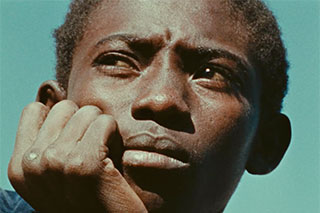
BADOU BOY
Director: Djibril Diop Mambéty
WRITTEN BY: Djibril Diop Mambéty
DIRECTOR OF PHOTOGRAPHY: Baidy Sow
STARRING: Laminé Ba, Al Demba Ciss, Christoph Colomb, Aziz Diop Mambéty
COUNTRY OF PRODUCTION: Senegal
LANGUAGE: French and Wolof with English subtitles
COLOR INFO: Color
RUNNING TIME: 56 miniutes
Restored by The Film Foundation’s World Cinema Project and Cineteca di Bologna at L’Immagine Ritrovata and L’Image Retrouvée laboratories in association with Teemour Diop Mambéty. Restoration funded by the Hobson/Lucas Family Foundation.
This restoration is part of the African Film Heritage Project, an initiative created by The Film Foundation’s World Cinema Project, the Pan African Federation of Filmmakers and UNESCO—in collaboration with Cineteca di Bologna—to help locate, restore, and disseminate African cinema.
NOTES ON THE RESTORATION:
BADOU BOY was restored in 4K using the internegative and the sound negative. Color grading was supervised by Pierre-Alain Meier.
Restoration work was carried out in 2021 at L'Immagine Ritrovata and L'Image Retrouvée laboratories.
With special thanks to Teemour Diop Mambéty.
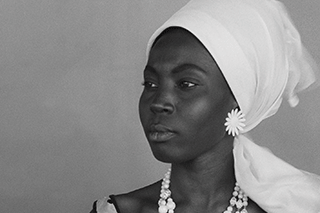
BLACK GIRL
LA NOIRE DE...
Director: Ousmane Sembène
WRITTEN BY: Ousmane Sembène
EDITING: André Gaudier
DIRECTOR OF PHOTOGRAPHY: Christian Lacoste
ASSISTANT CAMERAMAN: Ibrahima Barro
STARRING: Mbissine Thérèse Diop, Anne-Marie Jelinek, Robert Fontaine, Momar Nar Sene, Ibrahima Boy
COUNTRY OF PRODUCTION: Senegal
LANGUAGE: French with English Subtitles
COLOR INFO: B&W
RUNNING TIME: 65 minutes
PRODUCTION COMPANY: Les Films Domirev
Restored by Cineteca di Bologna/ L’Immagine Ritrovata laboratory, in association with the Sembène Estate, Institut National de l’Audiovisuel, INA, Eclair laboratories and the Centre National de Cinématographie. Restoration funded by The Film Foundation’s World Cinema Project.
Black Girl, or La Noire de…, was the first of Ousmane Sembène’s pictures to make a real impact in the west, and I can clearly remember the effect it had when it opened in New York in 1969, three years after it came out in Senegal. An astonishing movie—so ferocious, so haunting, and so unlike anything we’d ever seen.
- Martin Scorsese, May 2015
I am not for “social realism” nor for a “cinema of signs” with slogans and demonstrations. For me revolutionary cinema is something else. If we managed to set up a group of cinéastes who all make cinema directed in the same direction, I believe that then we could influence a little bit of the destinies of our country. I think that the film, more than the book, can crystallize an awakening within the masses. I am personally inspired much by the example of Brecht.
- Ousmane Sembène
In 1961, shortly after Senegal declared its independence from France, Ousmane Sembène, a self-educated dockworker, assigned himself an impossible task: to create a true African cinema as a “night school” for his people. is explosive debut—a film described as the first African feature (true in spirit, if not in fact)—inspired a form of fearless, socially engaged, and uncompromising cinema across the globe. La Noire de … (Black Girl) follows a young girl lured to France by a white bourgeoisie couple, who keep her locked in their flat as a housekeeper. As the daily and unrelenting indignities unfold, Diouana, the title character, literally loses her voice. Sembène highlights her silence, familiar to the voiceless across the globe, yet reveals Diouana’s immense dignity and, by the end, agency. He draws visually from the French Nouvelle Vague (in a film about racial and class divides, the black-and-white photography carries new power) and spiritually from the Italian neorealists, but the film’s heart and soul is African. By turning around the camera—used for 100 years to demean Black people—Sembène offers us the first humanistic gaze at Africans.
But the film (shot mostly in Dakar) also remains a seminal work of cinematic art, as it unfolds with startling precision and decisiveness, providing revealing, unforgettable and richly metaphoric perspective on a never-beforeseen Africa. La Noire de … became a sensation at festivals from Carthage to Pyongyang, and Sembène became the first non-French recipient of the Prix Jean Vigo, given previously to Alain Resnais, Chris Marker, Claude Chabrol and Jean-Luc Godard. In the film’s culminating moment, a boy grabs a mask and haunts the white businessman who entrapped Diouana. As this child pulls the mask from his face, we wonder: Will a new Africa emerge? Nearly 50 years after its initial screenings, the visionary La Noire de … remains a gorgeous, shocking and of-the-moment African story.
- Samba Gadjigo and Jason Silverman
NOTES ON THE RESTORATION:
The restoration of La Noire de… was made possible through the use of the original camera and sound negative provided by INA and the Sembène Estate and preserved at the CNC – Archives Françaises du Film.
In order to try and minimize the presence of visible spots (due to processing errors and aggravated by time) and scratches on the image, the camera negative was wet-scanned at 4K resolution. Due mainly to these two issues, the digital restoration required considerable efforts. A vintage print preserved at the Cinémathèque Française was used as reference.
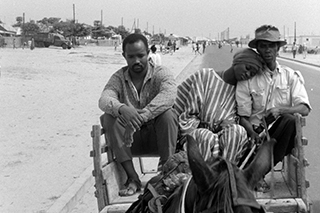
Borom Sarret
Director: Ousmane Sembène
WRITTEN BY: Ousmane Sembene
EDITING: Andre Gaudier
DIRECTOR OF PHOTOGRAPHY: Christian Lacoste
ASSISTANT CAMERAMAN: Ibrahima Barro
FROM: INA/Éclair/Cineteca/Sembene Family
STARRING: Ly Abdoulay, Albourah
COUNTRY OF PRODUCTION: Senegal
LANGUAGE: French and Wolof
COLOR INFO: Black and White
RUNNING TIME: 22'
ON COMPANY: INA
Restored in 2013 by Cineteca di Bologna/L’Immagine Ritrovata laboratory and Laboratoires Éclair, in association with The Film Foundation’s World Cinema Project, the Institut National de l’Audiovisuel, and the Sembène Estate. Restoration funded by Doha Film Institute.
I think given the fact that there is such a diversity of languages in Africa, we, African filmmakers, will have to find our own way in order to ensure that the message be understood by everyone, or we’ll have to find a language that comes from the image and the gestures. I think I would go as far as to say that we will have to go back and see some of the silent films and in that way find new inspiration.
Contrary to what people think, we talk a lot in Africa but we talk when it’s time to talk. There are also those who say blacks spend all of their time dancing – but we dance for reasons which are our own.
Dancing is not a flaw in itself, but I never see an engineer dancing in front of his machine, and a continent or a people do not spend its time dancing.
All of this means that the African filmmaker’s work is very important – he must find a way that is his own, he must find his own symbols, even create symbols if he has to.
[...] I then realized Borom Sarret, my first true short film. It is the story of a cartman who is, to some extent, the taxi driver of a horse-drawn cart. Confronted by a rich customer in a residential district prohibited to such a type of vehicle, a cop stops him, makes a complaint, and seizes the cart. Relieved of his livelihood, the poor fellow remains sadly in his place. His wife entrusts the guardianship of their children to him while saying to him “We will eat this evening…” For this I got the first work prize at the Festival of Tours in 1963.
-Ousmane Sembène
NOTES ON THE RESTORATION:
The restoration of Borom Sarret was made possible through the use of the original camera and sound negatives provided by INA and preserved at Éclair Laboratories.
The film was scanned in 4K at Éclair Laboratories and restored at L’Immagine Ritrovata laboratory. The image was digitally stabilized and cleaned, and all wear marks were eliminated. Image grading helped recover the richness of the original cinematography.
After scanning, the sound was digitally cleaned and background noise reduction was applied to eliminate all wear marks, without losing any of the dynamic features of the original soundtrack.
The World Cinema Foundation would like to specially thank Alain Sembène and the Sembène Family for facilitating the restoration process.
Image: © Courtesy of INA
